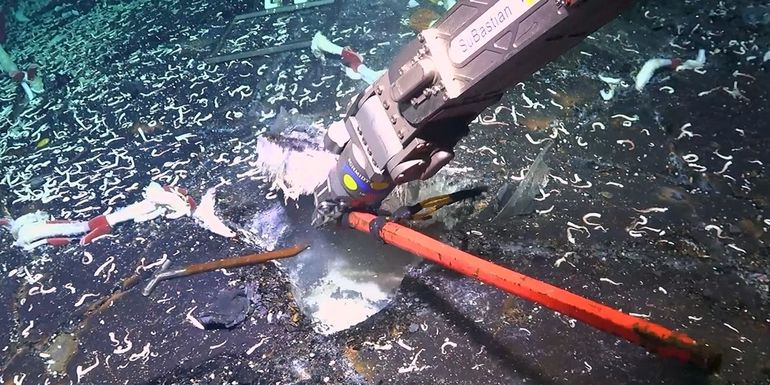New subterranean habitats
The discovery was made by an international team including marine biologist Sabine Kolner from the Royal Netherlands Institute of Marine Research (NIOZ). “Scientists have studied hydrothermal vents for the past 46 years, but never looked for animals under these volcanic hot springs,” said Sabine Koelner. “We were thrilled to see the underground vents teeming with life. This discovery adds a new dimension to hydrothermal vents and shows that life exists both above and below the ocean floor.”
“Our understanding of animal life in deep-sea hydrothermal vents has been greatly expanded with this discovery,” said expedition leader Monica Bright. “There are two dynamic habitats. Above-ground and below-ground animals thrive in harmony, depending on the liquid from below and the oxygen in seawater from above.”
A unique Dutch experiment
The expedition took scientists to a 2,500-meter-high submarine volcano on the East Pacific Rise in Central America. To determine whether animals move through warm springs, the science team used the Schmidt Ocean Institute’s underwater robot ROV SuBastian and new equipment developed by NIOZ. “We developed special mesh boxes in the Netherlands that were glued into cracks in the Earth’s crust,” says Sabine Kolner. “When we removed the crates after several days, we discovered animals living below the surface in hydrothermal vents.”
Animals travel underground
In addition, the researchers found evidence that animals from springs, such as tube worms, can travel down to the ocean floor through fluid from springs to colonize new habitats. Tubeworms are one of the most popular animals of hydrothermal vents, but very few hatchlings of these animals are found in the waters above hydrothermal vents. This has led scientists to suspect that new hydrothermal vents are moving below the Earth’s surface to form new communities.
At hydrothermal vents, hot water surfaces through cracks in the Earth’s crust as a result of tectonic activity. If a new hydrothermal vent appears, the ecosystem will quickly follow suit. Animals colonize an area within a few years. Scientists don’t know how animal larvae find new hot springs. An international committee is going to investigate this first. Researchers are now confirming that tubeworm larvae can settle and even live under the seabed. The discovery of an entirely new ecosystem beneath the seabed is proof of that.
Images of life under the sea and descriptions by researchers (Source: Schmidt Ocean)
Explore our ocean to the fullest
“Discoveries made during each Schmidt Ocean Institute (SOI) expedition underscore the urgency to fully explore our oceans so we know what’s in the deep ocean,” said President and Co-Founder Wendy Schmidt. “The discovery of new animals, landscapes and now entirely new ecosystems shows how much there is still to discover about our oceans — and how important it is to protect what we don’t yet know or understand.”
“We have long known about animals that live in caves, sand and mud on land, underground and in the sea. But for the first time, scientists have looked under hydrothermal vents,” said Jyotika Virmani, executive director of SOI. . “This truly remarkable discovery of a new ecosystem hidden beneath another ecosystem provides new evidence that life exists in unlikely places. The Schmidt Ocean Institute is proud to have provided a platform for Dr. Bright and his team to gain new insights. Collect in these systems. That may be vulnerable to deep-sea mining.”
Cooperation
A voyage on a research vessel Falkor (also) The SOI was chaired by Monika Bright from the University of Vienna. Together with an international scientific team from the Netherlands, USA, Germany, France, Costa Rica and Slovenia, he studied submarine volcanoes in the East Pacific Rise, west of Central America.
Text and photos: NIOZ (Lead photo: puitalen en kokerwormen)
Image: Schmidt Ocean Institute

“Coffee fanatic. Friendly zombie aficionado. Devoted pop culture practitioner. Evil travel advocate. Typical organizer.”

